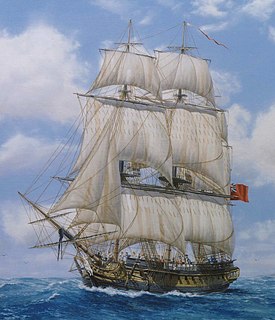Citations
- ↑ "No. 15407". The London Gazette . 15 September 1801. p. 1145.
Nine ships of the Royal Navy and one of the Royal Fleet Auxiliary have been named Argus, after Argus, the hundred-eyed giant of mythology:
Thirteen vessels of the Royal Navy have borne the name HMS Mohawk, after the Mohawk, an indigenous tribe of North America:
Six ships of the Royal Navy have been called HMS Imogen or HMS Imogene. A seventh was planned but never built:
Numerous Royal Navy vessels have been named HMS Dolphin after the dolphin.
Eleven ships of the Royal Navy have borne the name HMS Hawk after the bird of prey, the hawk:

Pomone was a 40-gun frigate of the French Navy, launched in 1785. The British captured her off the Île de Batz in April 1794 and incorporated her into the Royal Navy. Pomone subsequently had a relatively brief but active career in the British Navy off the Atlantic and Mediterranean coasts of France before suffering sufficient damage from hitting a rock to warrant being taken out of service and then broken up in 1803.
Sixteen ships of the Royal Navy have borne the name HMS Alert, while another was planned:
Seven ships of the Royal Navy have borne the name HMS Penguin. A penguin is a flightless aquatic bird.
Twelve ships of the Royal Navy have borne the name HMS Mosquito, or the archaic HMS Musquito, after the tropical insect, the Mosquito:

HMS Melampus was a Royal Navy fifth-rate frigate that served during the French Revolutionary and Napoleonic Wars. She captured numerous prizes before the British sold her to the Royal Netherlands Navy in 1815. With the Dutch, she participated in a major action at Algiers and, then, in a number of colonial punitive expeditions in the Dutch East Indies.
Thirty-nine vessels of the Royal Navy and its predecessors have borne the name Swallow, as has one dockyard craft, one naval vessel of the British East India Company, and at least two revenue cutters, all after the bird, the Swallow:

HMS Spitfire was a Tisiphone-class fireship of the Royal Navy. She served during the years of peace following the end of the American War of Independence, and by the outbreak of the French Revolutionary Wars, had been reclassified as a 14-gun sloop-of-war. Spitfire went on to serve under a number of notable commanders during a successful career that saw her capture a considerable number of French privateers and small naval vessels. She spent most of her career in Home waters, though during the later part of her life she sailed further afield, to the British stations in North America and West Africa. She survived the Napoleonic Wars and was eventually sold in 1825 after a period spent laid up.

HMS Favourite was a 16-gun Cormorant-class sloop of the Royal Navy, launched in 1794 at Rotherhithe. The French captured her in 1806 and renamed her Favorite. However, the British recaptured her in 1807 and renamed her HMS Goree. She became a prison ship in 1810 and was broken up in Bermuda in 1817.
Seventeen ships of the Royal Navy have borne the name HMS Dispatch, or the variant HMS Despatch:
A number of ships of the Royal Navy have borne the name HMS Diligence.
Sixteen ships of the Royal Navy have borne the name HMS Hope:
Nine ships of the Royal Navy have borne the name HMS Dart, after the River Dart in Devon:
A number of ships of the Royal Navy have borne the name HMS Diligent.
Several vessels have been named Leander for one the protagonists in the story of Hero and Leander in Greek mythology.